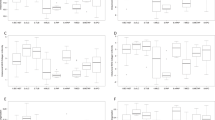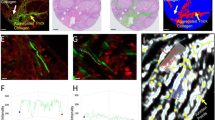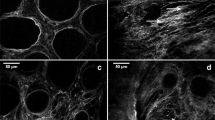Abstract
The morphological study was aimed at determining the role of fibrillar organization of the collagen-containing connective tissue of prostate cancer at the stage of neoplastic proliferation, including metastatic spreading into bone tissue. The histological material of 55 patients with prostate cancer, Gleason six to nine malignancy score, without neoplastic proliferation and with metastases into bones, was used. The architectural specificities of collagen-containing connective tissue of neoplasms were determined using Van Gieson’s method. It was found that the remodeling of collagen-containing connective tissue around the epithelial tumor structures with aggressive prostate cancer (Gleason score of eight to nine) resulted in the increase in the percentage of extended and flattened fibrils as compared to curved fibrils; the adjacent and surrounding stroma was notable for the enlarged total area of collagen-containing fibrils, manifestations of desmoplasia, compactization of the location, widening, flattening, and extending. The data obtained demonstrate that the remodeling of collagen-containing connective tissue components of prostate cancer conditions unrestricted migration and invasion of tumor cells, including those expressing the proteins involved in bone tissue remodeling.



Similar content being viewed by others
Change history
04 December 2023
An Erratum to this paper has been published: https://doi.org/10.3103/S0095452723060129
REFERENCES
Angel, P.A. and Zambrzycki, S.C., Predictive value of collagen in cancer, Adv. Cancer Res., 2022, vol. 154, pp. 15–45. https://doi.org/10.1016/bs.acr.2022.02.004
Angel, P.M., Spruill, L., Jefferson, M., et al., Zonal regulation of collagen-type proteins and post-translational modifications in prostatic benign and cancer tissues by imaging mass spectrometry, Prostate, 2020, vol. 80, no. 13, pp. 1071–1086. https://doi.org/10.1002/pros.24031
Badaoui, M., Mimsy-Julienne, C., Saby, Ch., et al., Collagen type 1 promotes survival of human breast cancer cells by overexpressing Kv10.1 potassium and Orai1 calcium channels through DDR1-dependent pathway, Oncotarget, 2018, vol. 9, no. 37, pp. 24653–24671. https://doi.org/10.18632/oncotarget.19065
Bodelon, C., Mullooly, M., Pfeiffer, R.M., et al., Mammary collagen architecture and its association with mammographic density and lesion severity among women undergoing image-guided breast biopsy, Breast Cancer Res., 2021, vol. 23, p. 105. https://doi.org/10.1186/s13058-021-01482-z
Drifka, C.R., Loeffler, A.G., Mathewson, K., et al., Highly aligned stromal collagen is a negative prognostic factor following pancreatic ductal adenocarcinoma resection, Oncotarget, 2016, vol. 7, no. 46, pp. 76197–76213. https://doi.org/10.18632/oncotarget.12772
Epstein, J.I., Egevad, L., Amin, M.B., et al., The 2014 International Society of Urological Pathology (ISUP) consensus conference on Gleason grading of prostatic carcinoma: Definition of grading patterns and proposal for a new grading system, Am. J. Surg. Pathol., 2016, vol. 40, no. 2, pp. 244–252. https://doi.org/10.1097/pas.0000000000000530
Fang, M., Yuan, J., Peng, Ch., and Li, Yu., Collagen as a double-edged sword in tumor progression, Tumor Biol., 2014, vol. 35, no. 4, pp. 2871–2882. https://doi.org/10.1007/s13277-013-1511-7
Garcia, A.M., Magalhes, F.L., Soares, J.S., et al., Second harmonic generation imaging of the collagen architecture in prostate cancer tissue, Biomed. Phys. Eng., 2018, vol. 4, p. 025026. https://doi.org/10.1088/2057-1976/aaa379
Gleason, D.F. and Mellinger, G.T., Classification of prostatic carcinomas, Cancer Chemother. Rep., 1966, vol. 50, no. 3, pp. 125–128.
Gole, L., Yeong, J., Lim, J.Ch.T., et al., Quantitative stain-free imaging and digital profiling of collagen structure reveal diverse survival of triple negative breast cancer patients, Breast Cancer Res., 2020, vol. 22. https://breast-cancer-research.biomedcentral.com/articles/10.1186/s13058-020-01282-x.
Guillaumin, J.-B., Djerroudi, L., Aubry, J.-F., et al., Proof of concept of 3-d backscatter tensor imaging tomography for non-invasive assessment of Human Breast Cancer Collagen Organization, Ultrasound Med. Biol., 2022, vol. 48, no. 9, pp. 1867–1878.
Necula, L., Matei, L., Dragu, D., et al., Collagen family as promising biomarkers and therapeutic targets in cancer, Int. J. Mol. Sci., 2022, vol. 23, p. 12415. https://doi.org/10.3390/ijms232012415
Ouellette, J.N., Drifka, C.R., Pointer, K.B., et al., Navigating the collagen jungle: The biomedical potential of Fiber Organization in Cancer, Bioengineering (Basel), 2021, vol. 8, no. 2, p. 17. https://doi.org/10.3390/bioengineering8020017
Pavlova, I.P., Nair, S.S., Lundon, D., et al., Multiphoton Microscopy for identifying collagen signatures associated with biochemical recurrence in prostate cancer patients, J. Pers. Med., 2021, vol. 11, no. 11, p. 1061. https://doi.org/10.3390/jpm11111061
Provenzano, P.P., Eliceiri, K.W., Campbell, J.M., et al., Collagen reorganization at the tumor-stromal interface facilitates local invasion, BMC Med., 2006, vol. 4, no. 1, p. 38. https://doi.org/10.1186/1741-7015-4-38
Rømer, A.M., Thorseth, M.L., and Hargbøl, D., Immune modulatory properties of collagen in cancer, Front. Immunol., 2021, vol. 12, p. 791453. https://doi.org/10.3389/fimmu.2021.791453
Shah, R.B., Current perspectives on the Gleason grading of prostate cancer, Arch. Pathol. Lab. Med., 2009, vol. 133, no. 11, pp. 1810–1816. https://doi.org/10.5858/133.11.1810
Song, K., Yu, Z., Zu, X., et al., Collagen remodeling along cancer progression providing a novel opportunity for cancer diagnosis and treatment, Int. J. Mol. Sci., 2022, vol. 23, no. 18, p. 10509. https://doi.org/10.3390/ijms231810509
Taufalele, P.V., VanderBurgh, J.A., Muñoz, A., et al., Fiber alignment drives changes in architectural and mechanical features in collagen matrices, PLoS, 2019. https://doi.org/10.1371/journal.pone.0216537
Xi, G., Guo, W., Kang, D., et al., Large-scale tumor-associated collagen signatures identify high-risk breast cancer patients, Theranostics, 2021, vol. 11, no. 7, pp. 3229–3243. https://doi.org/10.7150/thno.55921
Xi, G., Qiu, L., Xu, S., et al., Computer-assisted quantification of tumor-associated collagen signatures to improve the prognosis prediction of breast cancer, BMC Med., 2021, vol. 19, p. 273. https://bmcmedicine.biomedcentral.com/articles/10.1186/s12916-021-02146-7.
Yavuz, B.G., Pestana, R.C., Abugabal, Y.I., et al., Origin and role of hepatic myofibroblasts in hepatocellular carcinoma, Oncotarget, 2020, vol. 11, pp. 1186–1201. https://doi.org/10.18632/oncotarget.27532
Zainab, H. and Sultana, A., Shaimaa. Stromal desmoplasia as a possible prognostic indicator in different grades of oral squamous cell carcinoma, Int. J. Oral Maxillofac. Pathol., 2019, vol. 23, no. 3, pp. 338–343. https://doi.org/10.4103/jomfp.JOMFP_136_19
Zhang, J., Liu, J., Zhang, H., et al., The role of network-forming collagens in cancer progression, Int. J. Cancer, 2022, vol. 151, no. 15, pp. 833–842. https://doi.org/10.1002/ijc.34004
Zundera, S.M., Gelderblom, H., Tollenaara, R.A., and Mesker, W.E., The significance of stromal collagen organization in cancer tissue: An in-depth discussion of literature, Crit. Rev. Oncol./Hematol., 2020, vol. 151, p. 102907. https://doi.org/10.1016/j.critrevonc.2020.102907
Author information
Authors and Affiliations
Corresponding authors
Ethics declarations
Conflict of interest. The authors declare that they have no conflicts of interest.
Statement of compliance with standards of research involving humans as subjects. All procedures performed in studies involving human participants were in accordance with the ethical standards of the institutional and/or national research committee and with the 1964 Helsinki Declaration and its later amendments or comparable ethical standards. Informed consent was obtained from all individual participants involved in the study.
Additional information
Translated by V. Mittova
The original online version of this article was revised: Modifications have been made to the Affiliations.
About this article
Cite this article
Naleskina, L.A., Lukianova, N.Y., Zadvornyi, T.V. et al. Remodeling the Architecture of Collagen-Containing Connective Tissue Fibers of Metastatic Prostate Cancer. Cytol. Genet. 57, 406–412 (2023). https://doi.org/10.3103/S0095452723050031
Received:
Revised:
Accepted:
Published:
Issue Date:
DOI: https://doi.org/10.3103/S0095452723050031




